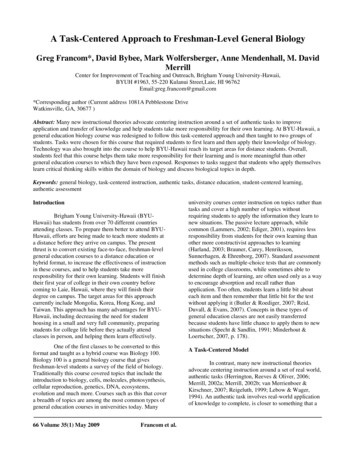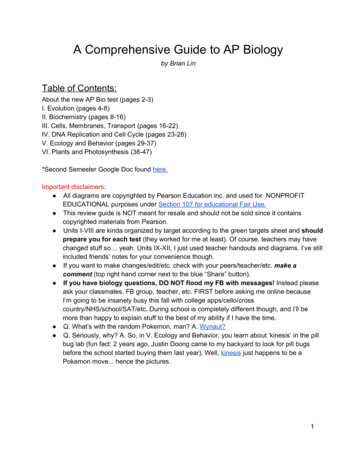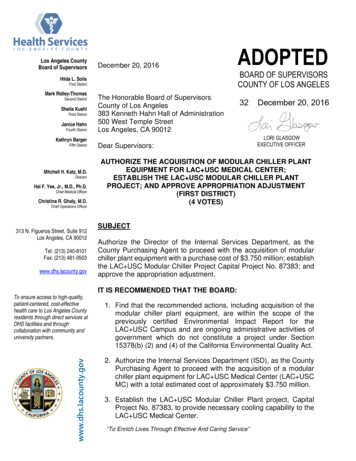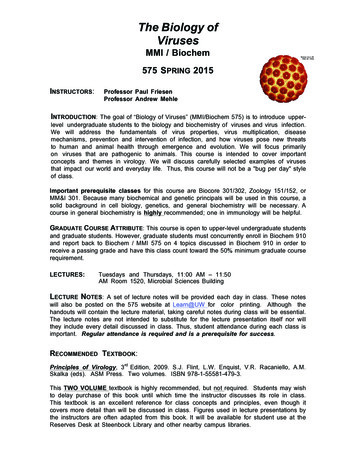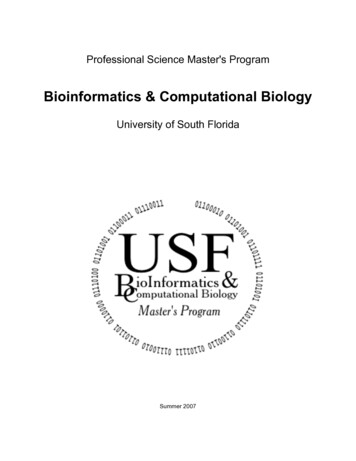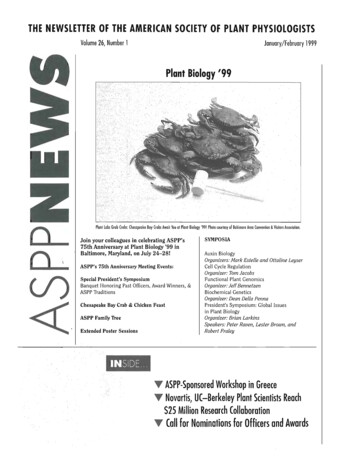
Transcription
THE NEWSLETTER OF THE AMERICAN SOCIETY OF PLANT PHYSIOLOGISTSVolume 26, Number 1January/February 1999Plant Biology '99IIIPlant lobs Grab Crabs: Chesapeake Boy Crabs Await You 01 Plant Biology '99! Photo courtesy of Baltimore Areo Convention & Visitors Association.Join your colleagues in celebrating ASPP's75th Anniversary at Plant Biology '99 inBaltimore, Maryland, on July 24-28!ASPP's 75th Anniversary Meeting Events:Special President's SymposiumBanquet Honoring Past Officers, Award Winners, &ASPP TraditionsChesapeake Bay Crab & Chicken FeastASPP Family TreeExtended Poster SessionsSYMPOSIAAuxin BiologyOrganizers: Mark Estelle and Ottaline LeyserCell Cycle RegulationOrganizer: Tom Jacobsfunctional Plant GenomicsOrganizer: JeffBennetzenBiochemical GeneticsOrganizer: Dean Della PennaPresident's Symposium: Global Issuesin Plant BiologyOrganizer: Brian LarkinsSpeakers: Peter Raven, Lester Brown, andRobert FraleyINSIDE . i.' .'I'T ASPP-Sponsored Workshop in GreeceT Novartis, UC-Berkeley Plant Scientists Reach 25 Million Research CollaborationT Call for Nominations for Officers and Awards
Future ASPP AnnualMeetings.CONTENTS1.·Plant Biology '99·31999'". ASPP-Sponsored Workshop in Greece;MbnagingEditor of Plant Physiology.Resigns'4Saturday, July 24, throughWednesday, July 28Baltimore, MarylandASPP's 75th anniversary.Public Affairs.''.-NSF's 85 Millibn in AwardsAdvances Plant Genome Reseprch- 56Miilion NSF Plant Genome .Program Includes: 20 Million forNewAwards- . 4 Mil1i6n Rice Genome Research.REP xpected from USDA,NSF, DOE NSF, USDA, DOE Expect CompleteGenome Sequence of Arabidopsisby 2000.meeting2000Saturday. July 15, throughWednesday, July 19San Diego, California.-Nbvartis UC-Berkeley Plant.ScientistsAg ee on 25 MillionResearch Collaboration51999 Awards Committees,'. Eduation Foundation Video ExplainsPlant Research Benefits.News from CSWIPP .,TravelGrantAward Program13VISection News1'4.People.Workshop in Chind.letter to the Editbr' .'15' ' ."',} '", r:17Obitu(lries. 1:8,.· .0-2atherI gs 21Jobs. 'c .i-::'·· : ::::··.Deadline for ."'Marth/AprllJ999, 4 " NEWS:) ." . ,.Jebruary 1q,J 99:;,2 IIIZ0-"'ASPPEducatior'lFoI'Lim' .'". '.1.--flresidentBrian A. Larkins ."."""""""" " ". 520·621·9958flresident·ElectDeborah Delmer """""""."""""""""""""""",,, 530·752·7561Immediate flost flresidentKen Keegstra yDaniel R. Bush "".,."""""""""",.,.""""""", 217·333·6109TreasurerTerri Lomax .""""."."""""""""""."""""", 541·737·5278Choir, Boord of TrusteesDouglas D. Randall .".""""""."."""""" 573·882·4847Choir, flublications CommitteeRebella Chasan ."""""""."."""""""""""" 202·628·1500Choir, Committee on theStatus of Women in fllont flhysio/ogyAnn M. Hirsch .""."""."""".""""""""" 310·206·8673Choir, Committee on Minority AffairsC. S. Prakash """""""""""""""""""""""""""" 334·727·8023Elected MembersVicki L. Chandler """"""""""""""""""""""""" 520·626·8725Joe Chappell .;." ",.""""""""""".,,",,.,. 606·257·4624Natasha V. Ralkhel .""""""""""""".""", 517·353·3518Sectional RepresentativesMidwesternMark Brodl .,."""""",.",,,.,,,,,,,,,,,,,,,,,,,,,,,, 309·341·7477NortheasternAlison Roberts """""""""""."""""""""""",,, 401·874,4098SouthernMarc.A. Cohn "."."""""""""""".""""""", 504·388·1464Washington, DCJanel P. Slavin """"""""""""""""""""""""""" 301·504·5629WesternDean Della Penna ters Office15501 Monona DriveRockville, MD 20855-2768 USAPhone: 301-251-0560Fax: 301-279-29969;'; .'".Call for Nominations for OfficersOndAwards10ASPPOFFICERS & STAFFU)«ASPP NEWS is distributed to allASPP members and is publishedsix times annually, in oddnumbered months. It is editedand prepared by ASPP stafffrom material provided by ASPPmembers and other interestedparties,Copy deadline is the 10th day ofthe preceding even-numberedmonth (for example, December10 for January/Februarypublication). Submit copy bye-mail whenever possible;submit all other copy by mail,not by lax.Contact: Nancy A, Winchester,Editor, ASPP NEWS, 15501Monona Drive, Rockville, MD20855-2768 USA; e-mailnancyw@aspp,org; telephone301·251·0560, ext. 17.Executive director, John Lisack, Jr., ext. ,,,,,,,,.,,,,.,,,,,,,,,,,,,, ilisock@ospp,orgExecutive assistant, Donna Gordon, ext. 31"""""""""""""""""""""""""""",,,,",,""",,,'" dgordon@ospp,orgDirector of finance and administration,Susan K. Chambers, ext. 11 """"""""',,"""'" chambers@ospp.orgAccountant, Sondra A. Gianco/l, ext. 40""""""""""""""""""".""""""""".",,,,,,,,,,,,,,,,, gionloli@ospp,orgInformation specialist, Perry Masciana, ext. 46",.""""""""".""""""""""""""""""""",,, mosciono@ospp.orgMember services coordinator,Kelley Noane, ext. 42 """"""""."""".",." knoone@ospp,orgAccounts receivable assistantRu Yang, ext. 43 """.""""""""""""."""""",. ruyong@Olpp,orgAdministrative assistantAmy Vollmer, ext. 22 """."""""""""",."" ovollmer@ospp,orgDirector of public affairs, Brion M. Hyps, ext. ,,,,,,,,,,,,,,,,,,,,,.,,, bhyps@ospp,orgFoundation assistant, Janice Jordan, ext. , iiordon@ospp,orgDirector of publicotlons,Nancy A. Winchester, ext. 17""".""""""""""""""""""""""""""""""",,, noncyw@aspp,orgflublicot/ons assistant, Sylvia J. Braxlon, ext. 33"""""""""""""""""".""""""""""""""",,, sbroxlon@ospp,orgManaging editor, fl/ont flhyslo/ogy,Deborah I. Weiner, ext. 18 """"""",,,.,,,,,,,,,,,,, dweiner@ospp,orgMonovin, editor, THE PLANT CEll,Cmprn B. Taylor, ext. 21 ."""""""""""""""",,, doylor@ospp,orgNews and reviews editor, THE PLANT CELl,Harry B. Smith, ext. 19 """"""""""""""".""" hsmith@ospp,orgflroduction editor, fl/ont flhysiology,Lauren Ransome, ext. 3D """""""""""""""" Ironsome@ospp,orgflroduction editor, fl/ant flhyslo/ogy,SUlaMe M. While, ext, 23 """".""",,,,,,,,,,,,,,, suzonne@ospp,orgflroductlon editor, THE PLANT CELl,Catherine A. Balogh, ext. 16 """""""'"'''''''''''''' balogh@ospp,orgMonusaipt manager, AMette Kessler, ext. 20"""""""""""."""""""""""""""""""""""""" okessler@Olpp,orgMonusaipt assistant, Kimberly A. Davis, ext. ,,.,,,,,,. kimdovis@ospp,orgMonusaipt assistant, Stephanie M. Butta, ext. 25"""."""""""""""""""""""""""."."""""."" bu"o@ospp,orgASPPNIWS
ASPP-Sponsored Workshop in GreeceSPP will be cosponsoring a workshop inGreece in collaboration with theMediterranean Agronomic Institute ofChania (MAICh). The goal of the workshop isto foster collaborations in research andtraining between ASPP scientists andscientists from countries with newlyestablished or developing programs in plantbiology.The workshop, entitled "Plant Sciences:Perspectives Beyond 2000," will be held inChania, an old port city on the island ofCrete from July 5 through July 16, 1999.MAICh will provide classroom, laboratory,lodging, and food facilities to participants.MAICh is one of the four centers that makeup the International Center for AdvancedMediterranean Agronomic Studies(CIHEAM). Established in 1962 under theauspices of the Council of Europe and theAOrganization for Economic Cooperation andDevelopment (OECD), CIHEAM is today anintergovernmental organization of 13countries: Albania, Algeria, Egypt, France,Greece, Italy, Lebanon, Malta, Morocco,Portugal, Spain, Tunisia, and Turkey. TheFood and Agricultural Organization (FAO)and the European Commission also supportthe activities of CIHEAM.The two-week workshop will involvelectures and laboratory sessions and providetime for small-group interactions. ProfessorKriton K. Hatzios, of the Virginia Polytechnic Institute and State University, is the U.S.coordinator for the workshop. Dr. AndreasDoulis, coordinator of studies at MAICh, isthe Greek coordinator. As of today, thefollowing ASPP members have agreed toparticipate as teachers in this workshop:Carole Cramer, Virginia Tech University,Richard Cyr, Penn State University, RichardDixon, Noble Foundation, Elizabeth Grabau,Virginia Tech University, Eva Pell, Penn StateUniversity, Ilya Raskin, Rutgers University,Athanasios Theologis, USDA Plant GeneExpression Center, and Kriton Hatzios,Virginia Tech University. The Greek andother European teachers will be selected inFebruary. Student participants will beselected from Mediterranean and Balkancountries with newly established programsin plant biology.For more information, contact AndreasDoulis (adoulis@maich.gr) in Greece orKriton Hatzios (hatzios@Vt.edu) in theUnited States. AWeb site with moreinformation about this workshop is availableat http://www.ppws.vt.edu.Deb Weiner Leaves Plant Physiologyeborah Weiner, managing editor of .leaves ASPP FebruaryD20th, after more than seven years' associaI.Plant Physiology,tion with the journal and the Society.Former executive director Mel Josephs andformer publicatiori director Jody Carlsonhired Deb in December 1991 and chargedher with bringing all editorial and peerreview functions in house. She and newlyappointed editor-in-chief Maarten Chrispeelsjoined forces in January 1992 to begin toplan for the transition to his editorship. Debfelt from the start that their partnershipwould be a successful blending of hereditorial capabilities and Dr. Chrispeel'sscientific vision: "We both quickly developedour respective areas of'management for thejournal. I learned a great deal from Maartenand am grateful for his support and strongleadership."Within a short time, Deb redesigned theinterior of the venerable journal, institutedfull-color covers, set up an in-house peerreview and manuscript-processing unit incollaboration with existing staff, enforced asystem that reduced the turnaround timefrom submission of manuscript to publication to six months, and helped convince theSociety to create an additional editorial staffposition dedicated to Plant Physiology. "Ifelt very challenged," she said recently. "I'mJanuary/February 1999, Vol. 26, No.1proud that all of those challenges have beenmet and that Plant Physiology is such asuccessful journal."Deb is well known in the scientificcommunity, having enjoyed excellentcommunications with probably thousands ofauthors and reviewers, as well as the PlantPhysiology editorial board members-morethan 100 prominent scientists-over theyears. "I leave with great respect for theboard's commitment and hard work, andgreat affection for many of the scientists Ihave had the privilege to work with."The feelings are mutual. Plant Physiologyassociate editor John Browse adds, "Deb'sprofessional competence and attention todetail, as well as her personal friendlinessand willingness to help, have been thehallmarks of her tenure as editor. We have allenjoyed working with her immensely andwish her the very best in her new position."Deb has also seen the headquartersoperation grow enormously in the past sevenyears and warmly acknowledges hercolleagues' dedication.She leaves the Society to join GeorgetownUniversity Press, where she will assume theposition of editorial and productionmanager. In 1998, the highly regarded presspublished 27 books in the areas of politics,international affairs, language and linguis-tics, religion, and ethics. It is activelypositioning itself for strong growth over thenext five years.Asearch for Deb's replacement at ASPP iscurrently under way.Deborah Weiner, monoging editor of Plant Physiology.- .:.- --------------------3
Public Affairs----------.,ri1 TNSF's S8S Million in Awards Advances Plant Genome ResearchThe National Science Foundation (NSF)announced 23 plant genome researchawards totaling 85 million over the nextfive years beginning in fiscal year 1998. Anumber of ASPP members were among thosereceiving awards.The awards will fund research thatcontributes to a better understanding at thegenome level of the inner workings of allplants, including economically importantcrops like maize (corn), soybean, tomato,and cotton, an NSF news release reported."These awards from the first year of theNSF plant genome research programrepresent a wide spectrum of activitiesranging from pilot technique developmentprojects to comprehensive, interdisciplinary,multi-institutional virtual centers," saysMary Clutter, NSF associate director,Directorate for Biological Sciences. "Futureresults from these awards are expected toprovide the fundamental knowledge and newtechnologies essential for the advancementof plant biology as well as crop improvement.Novel, value-added, plant-based products willbe the likely result. Outcomes of these grantswill be exploited by the agricultural sectorand other plant-based industries in developing improved plants of economic value."ASPP member Thea Wilkins, of theUniversity of California, Davis, will study thegenome of the world's leading natural fiber,cotton. Cotton is a major contributor to theU.S. and global economies, prqviding about55 percent of the fiberused in textilemanufacturing. Wilkins and collaboratorswill investigate certain cotton genes thatimpart unique, economically importantproperties to the fiber. "Enhanced understanding of this complex trait holds greatpromise for the genetic improvement ofcotton," Wilkins stated.The tomato is another economicallyimportant crop being studied by scientistsfunded through this NSF program. ASPPmember Steven Tanksley, of CornellUniversity, al'ld his collaborators willinvestigate how genes control the development and ripening of tomatoes, as well asthe plants' responses to infection.Genes often work together when plantsdevelop tolerance for environmental stresses.Grantee and ASPP member Nina Fedoroff, ofPenn State University, will attempt toidentify groups of genes whose patterns4L.--change when a plant is environmentallystressed. She will use ozone and pathogenattack as experimental stressors in mustardplants. Her research involves development ofa new technology called a DNA microarraydetection system. This system, it is hoped,will eventually be used by researchersthroughout the field of plant genomebiology.The NSF Plant Genome Research Programis the initial phase of an interagencyNational Plant Genome Research Initiativerecommended in May 1997 by the WhiteHouse Office of Science and TechnologyPolicy. The plant genome funds wereproposed by Senator Christopher Bond (RMO), who succeeded in gaining approval byCongress of a combined total of 90 millionfor plant genome research over fiscal years1998 and 1999.Following is a list of grantees:Bohnert, Hans J., University of Arizona,Purdue University (subaward), OklahomaState University (subaward); Genomics ofPlant Stress Tolerance; 8,270,704; fouryears.Cande, W. Zacheus, University of California, Berkeley; An Integrated Map of Cytological, Genetic and Physical Information ofMaize; 762,977; four years.Coe, Edward H., University of Missouri,University of Georgia (subaward), ClemsonUniversity (subaward); ComprehensiveGenetic, Physical, and Database Resource forMaize; 1l,075,485; five years.Cook, Douglas, Texas A&M University,University of Georgia (subaward), Universityof Minnesota (subaward); MedicagoTruncatula as the Nodal Species for Comparative and Functional Legume Genomics; 3,440,561; three years.Delmer, Deborah P., University ofCalifornia, Davis, Texas Tech University (subaward); Comparative FunctionalGenomics of the celA Gene Family in Plants; 819,818; three years.Doebley, John F., University of Minnesota,North Carolina State University (subaward),University of California, Irvine (subaward);Evolutionary Genomics of Maize; 5,847,106; five years.Dooner, Hugo K., Rutgers University; Useof the Transposon AC as a Gene-SearchingEngine in the Maize Genome; 1,334,173;three years.Fedorofr, Nina v., Pennsylvania StateUniversity; New DNA Microarray DetectionTechniques in the Study of Stress-InducedChanges in Plant Gene Expression; 1,801,988; three years.Green, Pamela J., Michigan StateUniversity, Carnegie Institution of Washington (subaward), Stanford University(subaward), Yale University (subaward),University of Wisconsin (subaward); AFunctional Analysis of the ArabidopsisGenome via Gene Disruption and GlobalGene Expression Analysis; 8,700,000; threeyears.Lam, Eric, Rutgers University; ChromaticCharting: Organization and Dynamics ofPlant Nuclear DNA in situ; 676,234; twoyears.Lemieux, Bertrand, University of Delaware, University of Illinois-Urbana(subaward), Massachusetts General Hospital(subaward); Genomic Analysis of SeedQuality Traits in Corn; 2,197,783; threeyears.Lightfoot, David A., Southern IllinoisUniversity, Texas A&M University (subaward);Integrative Physical Mapping of the SoybeanGenome; 1,303,664; three years.Martienssen, Robert, Cold Spring HarborLaboratory, University of California, Berkeley(subaward); Center for ComparativeGenomics in Model and Crop Plants; 1,842,208; three years.Phillips, Ronald L., University of Minnesota; A Radiation Hybrid and Cloning Systemfor the Genetic and Physical Mapping of theCorn Genome; 1,830,669; three years.Pratt, Lee, University of Georgia, CornellUniversity (subaward), Clemson University(subaward); Cross-Linked Sorghum and RicePhysical Maps as a Foundation for AnalyzingGenome Structure, Function, and Variationin C4 Grasses; 3,247,755; three years.Preuss, Daphne K., University of Chicago,Texas A&M University (subaward); PlantCentromere Functions Defined by TetradAnalysis and Artificial Chromosomes; 2,274,211; five years.Sung, Z. Renee, University of California,Berkeley; Repackaging the Corn Genome forMolecular Mapping; 301,072; two years.Tanksley, Steven D., Cornell University,Boyce Thompson Institute (subaward), TexasA&M University (subaward); Development ofTools for Tomato Functional Genomics:ASPPNEWS
Application to Analysis of Fruit Development, Responses to Pathogens, and GenomeSynteny with Arabidopsis; 4,648,484; threeyears.Venter, Craig, The Institute of GenomicResearch; Generation of a Tomato ESTDatabase; 3,246,725; three years.Vodkin, Lila 0., University of IllinoisUrbara, Iowa State University (subaward),University of Missouri (subaward), Universityof Minnesota (subaward), Northern ArizonaUniversity (subaward); AFunctionalGenomics Program for Soybean; 4,460,359;four years.Walbot, Virginia, Stanford University,University of Arizona (subaward), Universityof California, Berkeley (subaward), Universityof California, San Diego (subaward),University of Illinois-Urbana (subaward),Iowa State University (subaward); MaizeGene Discovery, Sequencing, and PhenotypicAnalysis; 12,548,370; five years.Wilkins, Thea A., University of California,Davis, University of Georgia (subaward),Texas Tech University (subaward), Iowa StateUniversity (subaward), Clemson University(subaWard); Structure and Function of theCotton Genome: An Integrated Analysis ofthe Genetics, Development and Evolution ofthe Cotton Fiber; 3,800,001; three years.Wing, Rod A., Clemson University; A BACLibrary Resource for Crop Genomics; 616,521; five years. 50 Million NSF Plant Genome Program Will Include 20 Million for New AwardsThe National Science Foundation willaward some 20 million in new plant genome research awards in fiscal year 1999 aspart of the second year of the 50 millionplant genome research program. Projectswill be supported at award levels ranging upto 3 million per year for one to five years.The remainder of the 50 million this yearwill go to continuing multiyear grants forplant genome research awarded initially inFY98.Full proposals must be submitted to NSFby January 29, 1999. NSF encourages applicants to submit letters of intent by December4,1998, before submitting a full proposal.The NSF request for proposal was sent by email to ASPP members on the ASPP CampusContact network when it was first issued.The Plant Genome Research Program supports projects that make significant contributions to the understanding of plant genome structure and function. Emphasis isplaced on plants of economic importanceand appropriate model systems that link genome information to function at the cellular,organismal, or evolutionary levels. Highthroughput, genome-wide approaches toplant genome research that build on recentadvances in genomics, bioinformatics, andplant biology are strongly encouraged in thisprogram. Proposals that deal with individualgenes or gene families should be sent toother programs in the NSF Directorate forBiological Sciences.It is anticipated that most projects will involve multiple investigators, including thosefrom disciplines outside biology. Manyprojects will also involve multi-institutionalnetworks organized as "virtual centers" or"centers without walls."Applicants should also consider providingan ideal environment for training young scientists in modern research technologies. Allproposals are expected to integrate researchand education and must include a welldesigned plan to increase participation ofmembers of underrepresented groups.When applicable, proposed research activities should be coordinated with internationalnetworks of research scientists. Innovativecollaborations with industry are encouraged.The Plant Genome Research Program wasinitiated by Senator Christopher Bond (RMO), who secured approval by Congress of 40 million in new funds for plant genomeresearch in FY98. The president's budget forFY99 included 40 million for plant genomeresearch. Bond succeeded in gaining an increase of 10 million for a total of 50 million in FY99.ASPP Campus Contacts and growers ofcorn and other crops suppo ted SenatorBond's Plant Genome Research Initiative.ASPP members were particularly active inseeking new funds for plant genome researchinstead of using existing biology researchfunds for corn genome research.1999 Awards CommitteesFollowing is a list of the membership of theASPP awards committees for 1999, asannounced by President Brian Larkins:M. Walker-Simmons (03)H. Kende (00), past winnerCHARLES F. KETTERING AWARDCORRESPONDING MEMBERSHIP(4-YEAR TERMS)L. Anderson (99), chairN. Baker (00)L. Griffing (01)R. Chollet (02)CHARLES ALBERT SHULL AWARDCHARLES REID BARNESLIFE MEMBERSHIPL. Anderson (99), chairK. Cline (00)R. Bressan (01)N. P. Jacobs (99), past winnerSTEPHEN HALES PRIZEJ. Key (99), chairC. West (01).::J.::.an:::ua:.:.!rY:.:.;/F eb:.:.:ru:.::ar".!.y.:.:19 99".!./.:.:Vo.:.:.1.R. Malkin (99), chairD. Bryant (01)S. Theg (03)B. Buchanan (00), past winner2:,:6:.:,./N;.:.o.:.;.lW. Silk (00), chairJ. Whitmarsh (02)J. Mullet (04)J. Schroeder (99), past winnerMARTIN GIBBS MEDALK. Keegstra (00), chairH. Sze (02)S. Wessler (04)W. Lucas (99), past winnerADOLPH E. GUDE, JR., AWARDM. Evans (00), chairH. Grimes (03)D. Delmer (06)M. Dilworth (01), past winnerDENNIS R. HOAGLAND AWARDL. Rappaport (03), chairR. Boston (99)T. Sharkey (05)B. Larkins (00), past winnerEXCELLENCE IN TEACHING AWARDM. Brodl (02), chairD. Dalton (99)J. Cheeseman (05)C. Reiss (01), past winner---Js
4 Million Rice Genome Research RFP Expected fromUSDA, NSF, DOESome 2 million of the 4 million increasefor the plant systems category of theUSDA National Research Initiative isexpected to go for rice genome research infiscal year 1999. Another 2 million isexpected to be provided by the NationalScience Foundation for this joint-agencyrequest for proposal (RFP). The Departmentof Energy is cooperating with this jointagency effort and may provide a smalleramount of funds for rice genome research.It is expected that 4 million would go torice genome research in FY2000 and FY2001if funds are available, making this a threeyear, 12 million effort. The 4 million ricegenome research program would come at atime when there is an international ricegenome sequencing effort.Some observers have pointed to a need forincreased U.S. investment in rice genomeresearch. In January 1998, a U.S. interagencycommittee recommended that the UnitedStates contribute 40 million and sequence20% of the rice genome over the next fiveyears. Rice genome research was not fundedin the FY98 NSF Plant Genome ResearchProgram.Science reported in an October 23,1998,article titled "Slow Start for U.S. RiceGenome Project" that thus far, only Japanhas put substantial money behind the ricegenome effort. Although France seems eagerto support some work, the European Unionwill not consider substantial support forsequencing the rice genome for a year, and itis not certain a commitment will be made atthat time. Japan began its sequencingprogram in April and could lose interest inan open-data policy if no one else is contributing, the article said.The expected joint-agency RFP will likelybe published in January. The RFP will besent bye-mail to ASPP Campus Contacts andwill be posted on the ASPP homepage athttp://aspp.org.NSF, USDA, DOE Expect to See Complete Genome Sequence of Arabidopsis byYear 2000 with Renewal of GrantsThe National Science Foundation (NSF),the Department of Energy (DOE), andthe Department of Agriculture (USDA), havefunded two groups of researchers throughrenewal grants to continue systematic largescale genome sequencing of Arabidopsisthaliana.The ultimate goal is to sequence the entireArabidopsis genome and to determine thestructure and function of every gene in thismodel plant by the end of 2000. Thecombined three-year awards total 28.3million.An NSF news release noted thatArabidopsis thaliana is a small plant in themustard family and has the smallest genomeand the highest gene density so far identifiedin a flowering plant. What scientists learnfrom the study of Arabidopsis will beimmediately applicable to economicallyimportant plant species, according to MaryClutter, NSF associate director, Directoratefor Biological Sciences, and will lead to thecreation of new and improved plants andplant-based products. "Because plants arevital to our existence, increased understanding of the biology of plants will impact everyfacet of our lives, from agriculture, to6energy, to the environment, to health," saysClutter.In 1990, the Multinational CoordinatedArabidopsis thaliana Genome ResearchProject was launched by an internationalgroup of scientists who recognized the needto examine in detail one simple plant withbasic features common to all plants. "Duringthe past several years, Arabidopsis hasbecome established worldwide as the speciesof choice for molecular genetic studies ofplant biology," says Clutter.Martha Krebs, director of DOE's Office ofScience (formerly the Office of EnergyResearch), noted that Arabidopsis genomeefforts have provided numerous scientificinsights, as well as potential commercialuses of interest to the energy community,including the high-volume production ofplastics. "Completion of the Arabidopsisgenome sequencing project will help advancelong-range research efforts toward engineering green plants for energy capture,production of energy-rich fuels and materials, and facilitating environmentalremediation," Krebs predicts.USDA Deputy Undersecretary EileenKennedy said, "Completing the sequencing- - - - - - - - - - - - -for the model plant Arabidopsis is the key tounlocking what comes after. It will helpscientists understand the basis for resistanceto disease and pests in agriculturallyimportant crops."The two groups of researchers selected forthe current research grants are The Institutefor Genomic Research in Rockville, Maryland, and a consortium of Stanford University, the University of Pennsylvania, and theUniversity of California, Berkeley. The twogroups are part of the international consortium AGI (Arabidopsis Genome Initiative)that includes an additional U.S. group atCold Spring Harbor Laboratory on LongIsland, New York, two groups in Europe, anda group in Japan."Activities will be coordinated to maximizeefficiency and usefulness," says Clutter, "andinformation from the project will be widelydisseminated so that researchers will gainmaximum benefits." Increased NSF supportfor Arabidopsis genome research was madepossible through the National Plant GenomeInitiative sponsored by Senator ChristopherBond (R-MO).A.;.SP P N EW S
Novartis, UC-Berkeley Plant Scientists Agree on 2S Million Research CollaborationASPP Members Negotiate PactThe Department of Plant and MicrobialBiology, in the College of NaturalResources at the University of California,Berkeley, will receive 25 million in researchfunding over five years in a researchagreement with the Novartis AgriculturalDiscovery Institute. Professor and department chair Bob Buchanan, a past presidentof ASPP, and Wilhelm Gruissem, pastdepartment chair and an ASPP member,helped in reaching this significant collaboration agreement with Novartis AgriculturalDiscovery Institute, Inc., and its president,Steven P. Briggs, also a member of ASPP.The following information from a UC-Berkeley news release (November 23, 1998) onthe landmark agreement provides details ofthe pact. The funding will support basic research in the department in the area of agricultural genomics. It will also provide accessto proprietary technology and DNA databases, which UC-Berkeley said will significantly enhance the university's ability to doresearch at the forefront of plant genomics.In return, Novartis scientists will workclosely with UC-Berkeley researchers, andthe company will receive first rights tonegotiate for a fraction-roughly 30-40percent-of the discoveries made in thedepartment. The fraction correspondsapproximately to the proportion of thedepartment's total research budget providedby Novartis and will ary from year to year.Novartis will pay patent costs, license fees,royalties, and all other costs normallyassociated with the commercialization ofresearch, Qut the university will own thepatents and collect royalties on their use."This is the first, though experimental,step in what we hope will be a long andfruitful relationship," said UC-BerkeleyChancellor Robert M. Berdahl. "Novartisbrings significant intellectual assets as wellas financial support to an important area
Robert Fraley SYMPOSIA Plant Biology '99 Special President'sSymposium Banquet Honoring Past Officers, Award Winners, & ASPP Traditions Chesapeake Bay Crab & Chicken Feast Join your colleagues in celebrating ASPP's 75thAnniversary at Plant Biology '99in Baltimore, Maryland, on July 24-28! ASPP Fam


